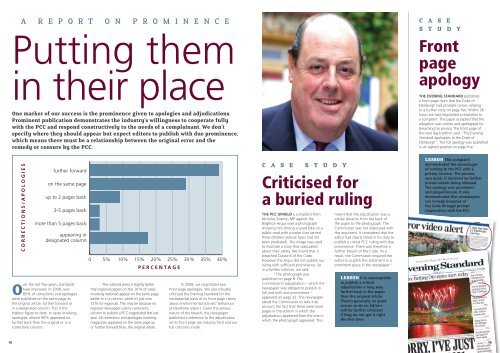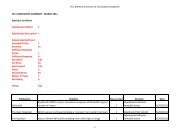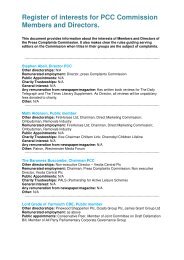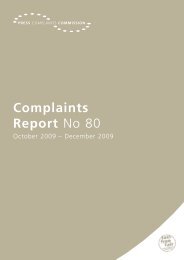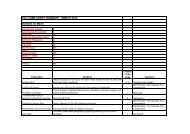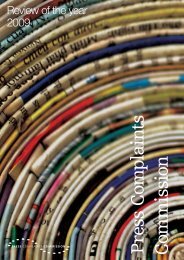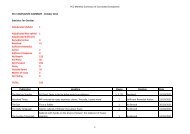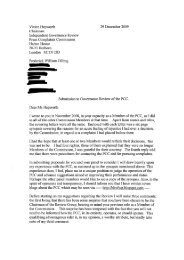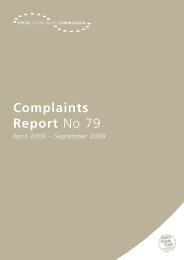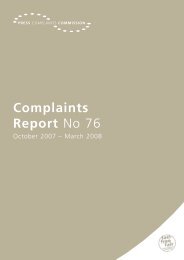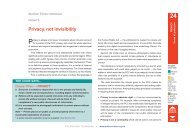2008 - Press Complaints Commission
2008 - Press Complaints Commission
2008 - Press Complaints Commission
You also want an ePaper? Increase the reach of your titles
YUMPU automatically turns print PDFs into web optimized ePapers that Google loves.
A R E P O R T O N P R O M I N E N C E<br />
Putting them<br />
in their place<br />
One marker of our success is the prominence given to apologies and adjudications.<br />
Prominent publication demonstrates the industry’s willingness to cooperate fully<br />
with the PCC and respond constructively to the needs of a complainant. We don’t<br />
specify where they should appear but expect editors to publish with due prominence,<br />
which means there must be a relationship between the original error and the<br />
remedy or censure by the PCC.<br />
C A S E<br />
S T U D Y<br />
Front<br />
page<br />
apology<br />
THE EVENING STANDARD published<br />
a front page claim that the Duke of<br />
Edinburgh had prostate cancer, relating<br />
to a further story on page five. Within 36<br />
hours we had negotiated a resolution to<br />
a complaint. The paper accepted that the<br />
allegation was untrue and apologised for<br />
breaching his privacy. The front page of<br />
the next day’s edition said: “The Evening<br />
Standard apologises to the Duke of<br />
Edinburgh”. The full apology was published<br />
in an agreed position on page five.<br />
CORRECTIONS/APOLOGIES<br />
further forward<br />
on the same page<br />
up to 2 pages back<br />
3-5 pages back<br />
more than 5 pages back<br />
appearing in<br />
designated column<br />
Over the last few years, standards<br />
have improved. In <strong>2008</strong>, over<br />
85% of corrections and apologies<br />
were published on the same page as<br />
the original article, further forward or<br />
in a designated column. This is the<br />
highest figure to date. In cases involving<br />
apologies, almost 90% appeared no<br />
further back than the original or in a<br />
corrections column.<br />
0 5% 10% 15% 20% 25% 30% 35% 40%<br />
PERCENTAGE<br />
The national press is slightly better<br />
than regional papers on this. 91% of cases<br />
involving nationals appear on the same page,<br />
earlier or in a column, whilst it’s just over<br />
72% for regionals. This may be because no<br />
regional newspaper used a corrections<br />
column to publish a PCC-negotiated text last<br />
year. All corrections and apologies involving<br />
magazines appeared on the same page as,<br />
or further forward than, the original article.<br />
In <strong>2008</strong>, we negotiated two<br />
front page apologies. We also robustly<br />
criticised the Evening Standard for the<br />
insubstantial basis of its front page claims<br />
about environmental activists’ behaviour<br />
at Heathrow airport. Given the serious<br />
nature of the breach, the newspaper<br />
published a reference to the adjudication<br />
on its front page (an industry first) and our<br />
full criticisms inside.<br />
C A S E S T U D Y<br />
Criticised for<br />
a buried ruling<br />
THE PCC UPHELD a complaint from<br />
Nicholas Soames MP against the<br />
Brighton Argus over a photograph<br />
showing him driving a quad bike on a<br />
public road with a trailer that carried<br />
three children (whose faces had not<br />
been pixellated). The image was used<br />
to illustrate a story that speculated<br />
about their safety. We found that it<br />
breached Clause 6 of the Code.<br />
However the Argus did not publish our<br />
ruling with sufficient prominence. So<br />
in a further criticism, we said:<br />
“The photograph was<br />
published on page 8. The<br />
<strong>Commission</strong>’s adjudication – which the<br />
newspaper was obliged to publish in<br />
full and with due prominence –<br />
appeared on page 32. The newspaper<br />
asked the <strong>Commission</strong> to take into<br />
account the fact that there were more<br />
pages in the edition in which the<br />
adjudication appeared than the one in<br />
which the photograph appeared. This<br />
meant that the adjudication was a<br />
similar distance from the back of<br />
the paper to the photograph. The<br />
<strong>Commission</strong> was not impressed with<br />
this argument. It considered that the<br />
editor had clearly failed in his duty to<br />
publish a critical PCC ruling with due<br />
prominence. There was therefore a<br />
further breach of the Code. As a<br />
result, the <strong>Commission</strong> required the<br />
editor to publish this statement in a<br />
prominent place in the newspaper.”<br />
LESSON It is unacceptable<br />
to publish a critical<br />
adjudication a long way<br />
further back in the paper<br />
than the original article.<br />
There’s generally no good<br />
reason to do so. Editors<br />
will be further criticised<br />
if they do not get it right<br />
the first time.<br />
LESSON This complaint<br />
demonstrated the advantages<br />
of coming to the PCC with a<br />
privacy concern. The process<br />
was quick. It involved no further<br />
private details being released.<br />
The apology was prominent<br />
and proportionate. It also<br />
demonstrated that newspapers<br />
can remedy breaches of<br />
the Code through prompt<br />
cooperation with the PCC.<br />
18<br />
19


